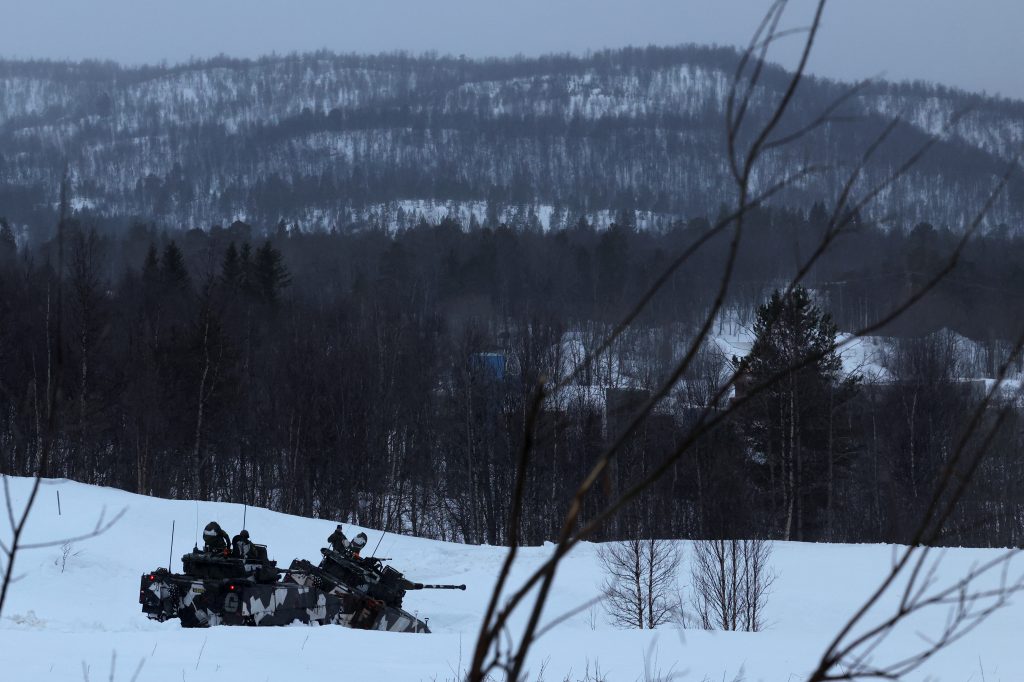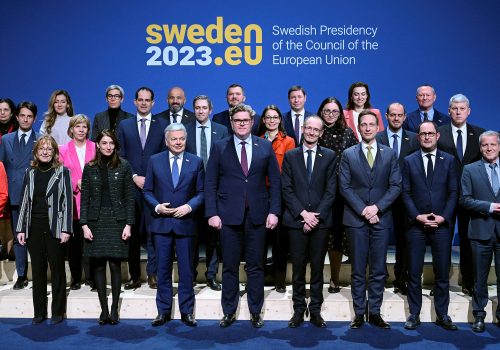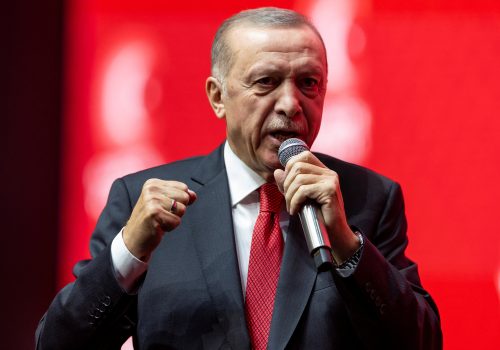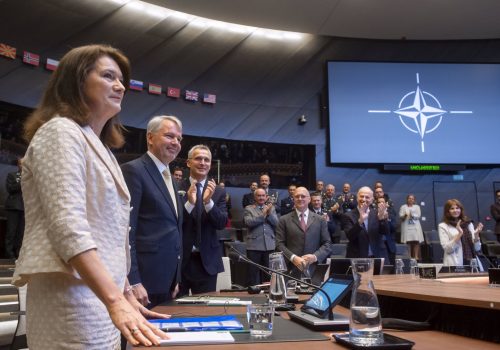After handing over their NATO membership applications in Brussels on May 18, 2022, Sweden and Finland’s accession proceeded with historic speed. By the end of September, twenty-eight of thirty countries had ratified—but that number remains unchanged more than four months later, with Turkey and Hungary keeping Finland and Sweden in the waiting room.
While the countries have moved “hand in hand” toward NATO thus far, Turkish President Recep Tayyip Erdogan’s threats to not support Swedish membership have led to discussions in Finland on whether to proceed without Sweden. A recent poll indicated that around 53 percent of Finns are willing to go ahead without Sweden.
However, for reasons of history, geography, and security, joining NATO together is still the goal and also the clearly expressed wish of both NATO and the United States—who have a strong interest in preserving Alliance unity at a perilous time amid the war in Ukraine. The possibility of Finland proceeding without Sweden, if the Swedish process were to be fully stopped, should be viewed as a last resort. Nonetheless, it is worth exploring the potential strategic and logistical implications of decoupling and the suboptimal outcomes created by such a move—including for Turkey, which could come away with no concessions if Sweden ends up a NATO member in all but name.
Finland’s options to go it alone
For Sweden, NATO membership has always been connected to the so-called “Finnish question,” i.e., not leaving Finland, with its long border with Russia, alone as the only military non-aligned state in the region. Now, the tables have turned and Finland may be faced with its own “Swedish question.”
After an active start to the joint accession process, a sense of disillusionment has started to creep in. Sweden’s Prime Minister Ulf Kristersson hinted in early January that Sweden had reached a dead end with Turkey, as Sweden was neither able nor willing to offer anything more. Sweden is in the process of revising its anti-terrorism legislation again; the current laws only entered into force last July. But the crux of the matter is Turkey’s demand for extraditions of alleged terrorists. Decisions on extradition cannot be made on political grounds in either Finland or Sweden and the process must, like in all other cases, go through the judicial system.
With the impasse likely to continue at least through Turkey’s elections in May, different options are increasingly being floated in Finland, should Turkey refuse to ratify both applications by the NATO Summit in Vilnius, Lithuania in July.
The most conceivable scenario in which Finland would go ahead without Sweden would be if Turkey and Hungary decide to ratify only Finland. Theoretically, Finland could wait for Sweden’s accession to be approved by Turkey and Hungary before taking the necessary last step of signing off on the North Atlantic Treaty. However, given the high support for NATO membership and public opinion in favor of not waiting for Sweden, it would be difficult for the Finnish government not to proceed alone.
Finland is unlikely to actively start pursuing a separate ratification—at least until after its parliamentary elections in early April. Separating the processes would also entail risks: There is no guarantee that Turkey would not come up with a separate list of conditions for Finland’s accession.
While it is a common argument from a Finnish perspective that Finland needs NATO membership more urgently than Sweden, considering that only Finland shares a border with Russia, the security situation at the Finnish-Russian border remains stable. Moreover, Russia is so tied down in Ukraine that it has little capacity left to intimidate Finland, and it will likely take years for Russia to recover from its losses and pose a serious military threat to Finland, with or without NATO membership. Therefore, it is not worth pushing forward at the expense of close relations with Sweden—which are of vital interest for Finland.
Currently, the hardest part for Finland is Sweden’s uncertain outlook. Finland’s Foreign Minister Pekka Haavisto recently made waves by hinting that, although the joint accession with Sweden remains the goal, Finland would have to reevaluate the situation if Sweden’s accession process “stalled indefinitely.” But the question is, how to define “indefinite”? Erdogan’s statements have not proven reliable so far, which makes it difficult to assess the time horizon of Turkey’s objectives. Finland’s approach to national security is an inherently pragmatic one but, in this case, the most pragmatic solution is not clear cut.
Sweden’s pivotal Nordic role
Finnish accession to NATO without Sweden would leave the Alliance with a strategic challenge in the middle of the Baltic Sea region. From NATO defense planners’ point of view, Sweden’s geographic position makes it particularly relevant for other regional allies’ security of supply and military mobility.
A joint Nordic accession to the Alliance would create one coherent geostrategic region running from the Arctic through the North Sea and Baltic Sea. Once a buffer for Sweden against Russian aggression, the Baltic Sea would become a regional security link. In times of crisis or war in the Baltics, Swedish air bases can readily receive NATO forces and send reinforcements. This is especially true for Gotland, an island off the southeastern coast of Sweden, which is 120 miles from Stockholm, 135 miles from Lithuania, and 185 miles from both the Russian exclave of Kaliningrad and Poland, giving the three Baltic states much-needed strategic depth.
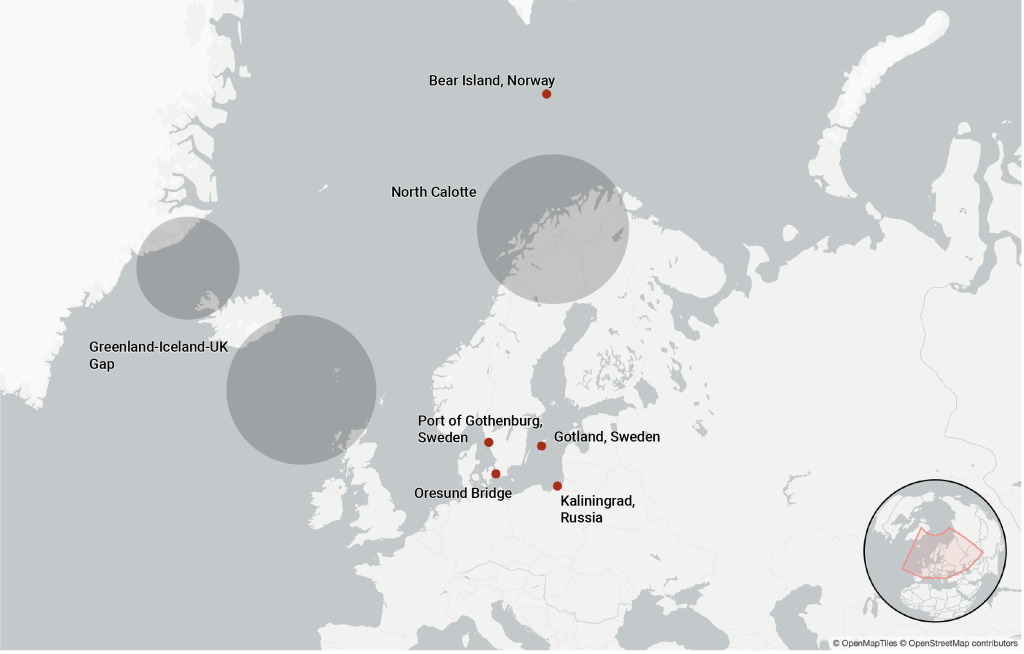
Sweden also provides land links from Germany and Denmark (via the Öresund bridge from Copenhagen to Malmö) in the south to Norway and Finland in the north. From the Atlantic, the port of Gothenburg is the Nordic region’s largest port and main entry point. If access to the Baltic Sea were contested or denied, Gothenburg provides overland routes with major European highways connecting to Oslo, Copenhagen, Northern Sweden, and Finland.
In the Arctic, a Swedish gap would also hamper the Alliance’s deterrence posture. Reinforcing the Arctic region in a crisis is essential in denying Russia the ability to cut off NATO allies from Scandinavia in the Greenland-Iceland-UK gap or along the Bear Island line. From the Norwegian Atlantic coastline, access to Finland runs through Sweden in the North Calotte.
Closing this Swedish gap has long been a challenge for NATO defense planners, particuarly in scenarios defending the Baltics. But with Russia’s war shattering peace in Europe and the Alliance’s new long Finnish border, it is even more urgent to fully integrate the region—even if Russia is preoccupied with its war against Ukraine for the time being.
Best friends forever?
Close Finnish-Swedish defense cooperation (known as “FISE cooperation”) is an important reason for the two nations to join NATO simultaneously. If Finland were to go ahead alone, it would complicate the bilateral arrangements and require the Alliance to find workarounds to integrate Sweden into regional defense plans without full NATO membership.
Reaching such high levels of trust, interoperability, and readiness is a result of years of joint training and planning across domains based on a series of bi- and multilateral memorandums. For example, the Nordic neighbors work particularly closely together in the air and sea domains and have established joint navy units. Under the Cross Border Training framework, the air forces of Finland, Sweden, and Norway have been exercising on a near-weekly basis since 2009 with access to each other’s airfields.
In the land domain, the Vigilant Knife exercise in September 2022 brought Swedish troops and the Archer artillery system under Finnish command, and it worked seamlessly, even though it was planned on short notice. “We no longer need to discuss how we think things would work,” said Swedish Brigade Commander Lars Jonsson, “we now have the empirical evidence.”
FISE cooperation has been put to use during Russia’s war in Ukraine as well, as Sweden and Finland signed a letter of intent last month to continue sending Finnish military aid to Ukraine using their armed forces’ joint operational planning.
The Swedish question
If Sweden’s accession is indefinitely delayed, the twenty-eight NATO members that have ratified Sweden’s membership could find ways to alleviate the strategic dilemmas described above through bi- or multilateral agreements on issues such as military mobility, security of supply, and access to Swedish territory. However, Sweden would be formally excluded from NATO’s defense planning and Article 5 security guarantee.
While waiting for the Turkish complications to be solved, Finland and Sweden are currently each negotiating new bilateral Defense Cooperation Agreements (DCA) with the United States, among other allies. In contrast to existing Statements of Intent, these new DCAs are binding contracts that will regulate the legal status of US troops and equipment on Swedish and Finnish territory. However, the negotiations were launched in anticipation of a swift NATO accession—and it is unclear how a prolonged delay in Sweden’s NATO process would impact them.
Striking different bilateral agreements with NATO members could enable Sweden to cherry-pick preferred partners. From a Turkish point of view, this would be bad news. Sweden would likely establish a considerable framework for close cooperation and even some form of security guarantees with key NATO countries, while disregarding Turkish security concerns.
Taking such a path may offer a pragmatic way out of this corner, but it could put the collective-defense principle of the Alliance into serious question. In the worst case, it could create different tiers of de facto membership if Sweden were integrated into the Alliance to a hitherto unprecedented extent but without full membership. For Sweden, as some sort of de facto NATO member but without the de jure status, it is unlikely that a “special regional responsibility” in developing a Nordic dimension within the Alliance, as proposed in the armed forces’ recommendations to the government, would materialize.
Exasperation is growing within the Alliance at Turkey’s stalling of the dual accessions. Sweden and Finland would undoubtedly be net security providers to the Alliance, and their membership application came just in the right moment—without the two new members, NATO would be hard-pressed to deliver on its promise “to defend every inch of Allied territory at all times” when it comes to the Nordic-Baltic region. No member of NATO, Turkey included, has an interest in the headache that leaving Sweden out in the cold would inevitably cause.
Eric Adamson is a project manager at the Atlantic Council’s Northern Europe office in Stockholm.
Minna Ålander is a research fellow at the Finnish Institute of International Affairs in Helsinki.
Further reading
Mon, Jan 30, 2023
Sweden has a chance to transform European security—even before it officially joins NATO
New Atlanticist By Franklin D. Kramer
Sweden can wield the agenda-setting powers of its presidency to push a EU security and defense budget directed toward three crucial aims: mobility, sustainment, and critical infrastructure protection.
Fri, Jan 27, 2023
What Turkey really wants from Sweden
New Atlanticist By Rich Outzen
Turkey likely will still approve Sweden's bid for NATO membership, but not until summer and only after President Recep Tayyip Erdogan gets more cooperation against the PKK.
Mon, Aug 8, 2022
When will Sweden and Finland join NATO? Tracking the ratification process across the Alliance.
New Atlanticist By
With this tracker, the Atlantic Council team is keeping tabs on the countries that have ratified the amended NATO treaty—and handicapping the political prospects for ratification in the rest.
Image: Swedish army members drive infantry fighting vehicles as part of military exercise called "Cold Response 2022", gathering around 30,000 troops from NATO member countries plus Finland and Sweden, amid Russia's invasion of Ukraine, in Setermoen in the Artic Circle, Norway, March 25 2022. REUTERS/Yves Herman
